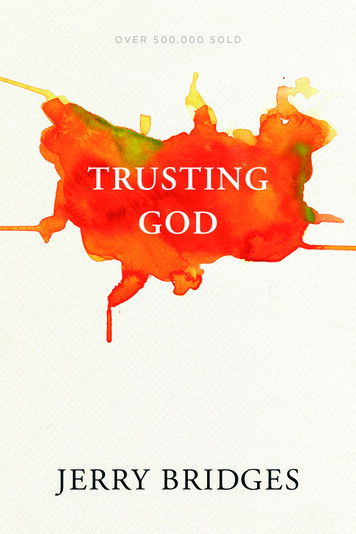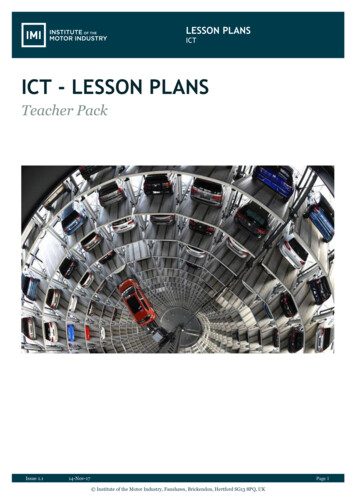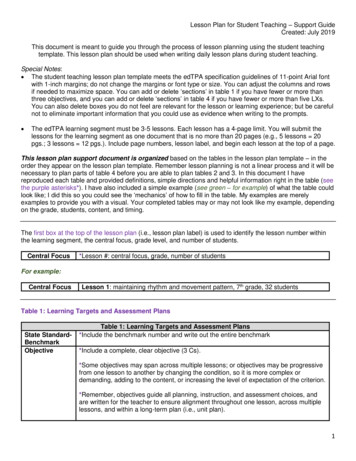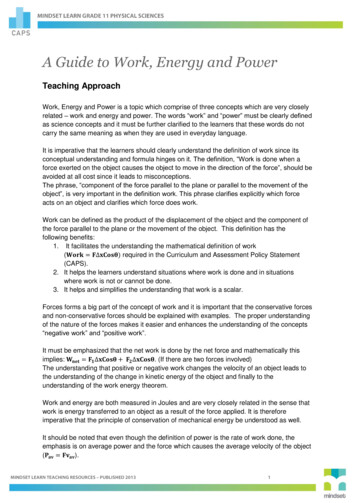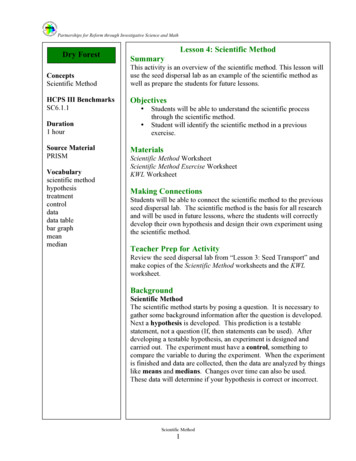
Transcription
Partnerships for Reform through Investigative Science and MathDry ForestConceptsScientific MethodHCPS III BenchmarksSC6.1.1Duration1 hourSource MaterialPRISMVocabularyscientific methodhypothesistreatmentcontroldatadata tablebar graphmeanmedianLesson 4: Scientific MethodSummaryThis activity is an overview of the scientific method. This lesson willuse the seed dispersal lab as an example of the scientific method aswell as prepare the students for future lessons.Objectives Students will be able to understand the scientific processthrough the scientific method.Student will identify the scientific method in a previousexercise.MaterialsScientific Method WorksheetScientific Method Exercise WorksheetKWL WorksheetMaking ConnectionsStudents will be able to connect the scientific method to the previousseed dispersal lab. The scientific method is the basis for all researchand will be used in future lessons, where the students will correctlydevelop their own hypothesis and design their own experiment usingthe scientific method.Teacher Prep for ActivityReview the seed dispersal lab from “Lesson 3: Seed Transport” andmake copies of the Scientific Method worksheets and the KWLworksheet.BackgroundScientific MethodThe scientific method starts by posing a question. It is necessary togather some background information after the question is developed.Next a hypothesis is developed. This prediction is a testablestatement, not a question (If, then statements can be used). Afterdeveloping a testable hypothesis, an experiment is designed andcarried out. The experiment must have a control, something tocompare the variable to during the experiment. When the experimentis finished and data are collected, then the data are analyzed by thingslike means and medians. Changes over time can also be used.These data will determine if your hypothesis is correct or incorrect.Scientific Method1
Partnerships for Reform through Investigative Science and MathVocabulary:scientific method: an organized way to answer a question; it has 6 stepshypothesis: a predictive statement that can be tested with an experimenttreatment: the tested part of the experiment, is used to determine the effects of somethingcontrol: the normal conditions in an experiment, is what the treatments are compared to.data: data are the information, or results, you collect during an experiment; data are used tomake conclusions about the experiment.data table: an organized way to display the databar graph: graphs used to visually compare datamean: the average, used with datamedian: the middle number (1,3,4,5,6,9,11,100,101; 6 is the median because it is the 5th numberin either direction)Procedure1. Get an update from the students to see how their brochures (introduced in Lesson 1) arecoming along. Provide help and guidance as needed.2. Hand out KWL worksheet and have the students fill out the first 2 questions. Then passout the Scientific Method worksheet.3. Go over the 6 steps of the scientific method, having the students follow along and fill outthe worksheet (the Scientific Method Diagram has the answers).Step 1: Ask a QuestionStep 2: Do Background ResearchStep 3: Construct a Hypothesis-a hypothesis is a predictive statement.Step 4: Test the hypothesis with an experiment-most experiments have a control,which is often un-manipulated treatment category and is more “natural”Step 5: Analyze the results and draw conclusionsStep 6: Report the resultsActivity 1: Group Discussion Series1. Topic: Seed dispersal and Scientific Method (Hand out the Scientific Method Exerciseworksheet and have the students fill it out as the discussion progresses.)Question 1: What was the question being asked in the seed dispersal activity?Answer: The general question was, “How are seeds spread or dispersed?”Question 2: What was learned about seed dispersal?Answer: In the last lesson, there was a section about how seeds can be spread by animals,water, wind, and explosive.Question 3: What hypothesis was tested?Answer: Different areas have different seeds and more seeds will be collected from onearea than another area.Scientific Method2
Partnerships for Reform through Investigative Science and MathQuestion 4: How was the hypothesis tested?Answer: This is the procedure from the experiment yesterday. Tape was attached to anankle, and a specific “habitat” was walked through. Then seeds and other things thatattached were counted.Question 5: Was there a control?Answer: No, this experiment was comparing two different areas. If for example, youwanted to compare the types and numbers of seeds from a fountain grass area to a dryforest, the dry forest would be your control and the fountain grass would be the“treatment,” meaning it is the variable being tested.Question 6: How were the results analyzed?Answer: Total numbers of things collected were compared between the different habitatsfrom the ecosystem map. Also, seeds vs. other thing things collected were examinedwithin each habitat.Question 7: What were the results?Answer: This should be their conclusions on the worksheet that they found based on theirbar graphs (data).Have the students finish filling out their KWL worksheet and hand it in.AssessmentsScientific Method WorksheetScientific Method Exercise WorksheetKWL WorksheetExtension ActivitiesHave the students write out an experimental design using the scientific method for growing theseeds that they collected with their socks.Example procedure:Hypothesis: Bean seeds will grow better than the rest of the seeds on the socks.Procedure:1. Plant 10 bean seeds and 10 other seeds, 2 in a pot. The seeds will be planted 1 cmbeneath the surface of the soil.2. The seeds will be watered daily, until the soil is moist.3. Once the seeds germinate, the height of the plant will be measured every 3 days for 15days.4. The change in plant growth over time will provide a mean growth rate and will begraphed.5. The surviving number of plants will also be graphed using bar graphs.Scientific Method3
Partnerships for Reform through Investigative Science and MathScientific Method Diagram:Scientific Method4
Partnerships for Reform through Investigative Science and MathName:Date:Scientific MethodWhat is a hypothesis?What is a control?How can you display your results?Scientific Method5
Partnerships for Reform through Investigative Science and MathAnswers:A hypothesis is a predictive statement. It is not a question.A control is typically used to compare your experiment (treatment) to. It is the normal settingand should not be manipulated.Results can be displayed in graphs and tables, like bar graphs.Scientific Method6
Partnerships for Reform through Investigative Science and MathName:Date:Scientific Method K-W-LWhat do you know about the scientific method?What do you want to know about the scientific method?What did you learn about the scientific method?Scientific Method7
Partnerships for Reform through Investigative Science and MathName:Date:Scientific method exercise1) What was the question being asked in the seed dispersal activity?2) What was learned about seed dispersal?3) What hypothesis was tested?4) How was the hypothesis tested?5) Was there a control?6) How were the results analyzed?7) What were the results?Scientific Method8
the scientific method. Teacher Prep for Activity Review the seed dispersal lab from "Lesson 3: Seed Transport" and make copies of the Scientific Method worksheets and the KWL worksheet. Background Scientific Method The scientific method starts by posing a question. It is necessary to







